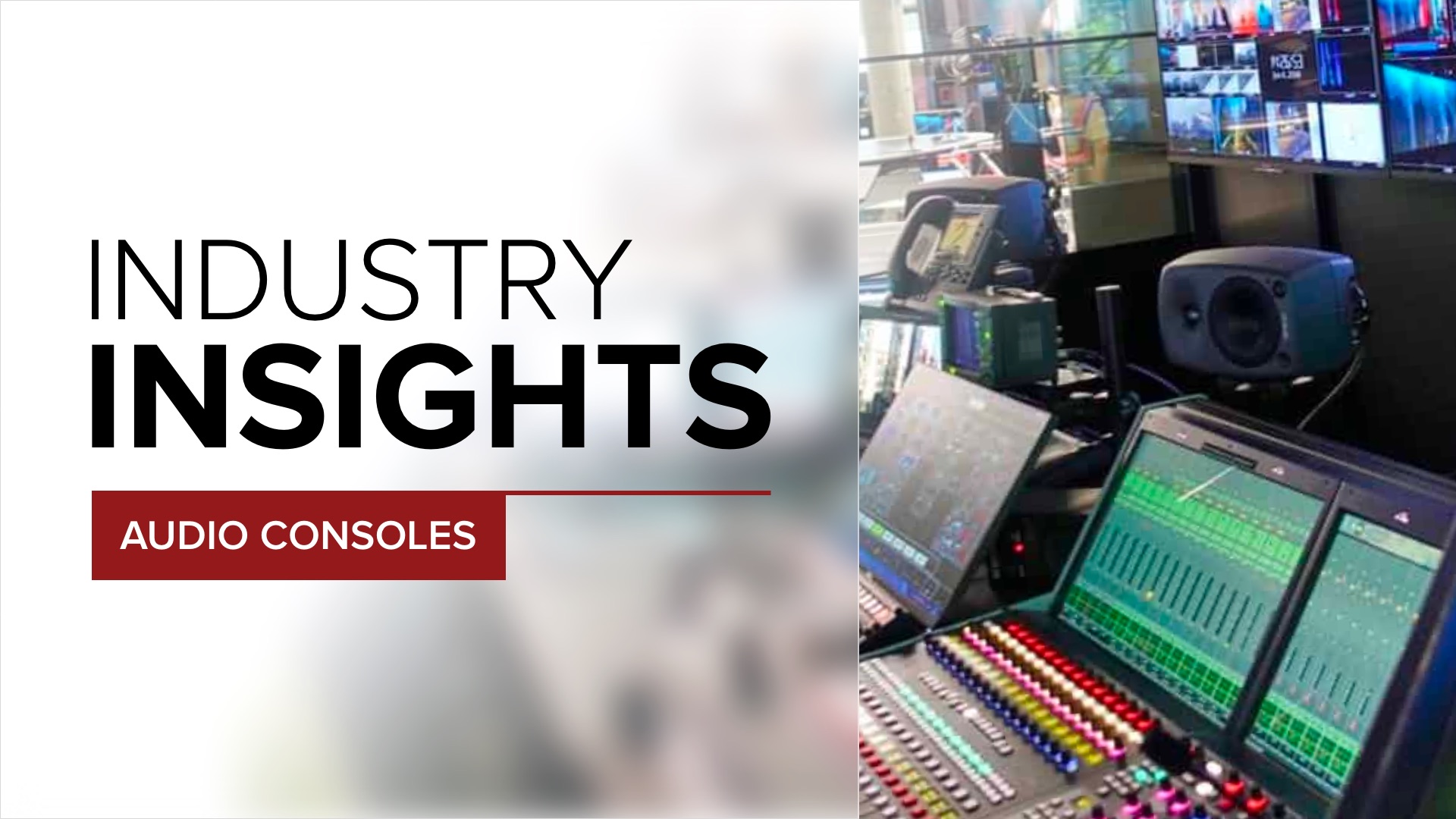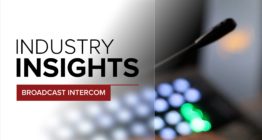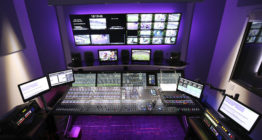Industry Insights: The future of audio mixing in broadcasting

Subscribe to NCS for the latest news, project case studies and product announcements in broadcast technology, creative design and engineering delivered to your inbox.
Flexibility of production and remote workflows are two keys focused on over the past year by broadcasters. How does that apply to broadcast audio?
In this installment of our Industry Insights roundtable, our experts from the field of broadcast audio solutions discuss audio consoles and the future of audio mixing.
How does working from home impact broadcast audio, generally?
“How about calling it ‘working in a distanced scenario’? Demanding one-off events like big entertainment productions will probably not allow A1s to work from home any time soon given the impromptu nature of certain decisions and situations during such a show. What we certainly see is that broadcasters and broadcast providers leverage their various control spaces and that fewer engineers need to do even more than before. Shows with a high predictability factor, on the other hand, are indeed increasingly mixed and/or supervised from home Mix Kitchen-style, using touchscreens and COTS fader panels, or relying on an automation system that can be monitored from home, especially for newscasts,” said Christian Struck, senior product manager of audio production at Lawo.
“Some studies reported that media consumption has risen, increasing demand for content, which broadcasters had to address by adjusting almost all aspects of the production and transmission chain. In the meantime, the quality of content was reduced as it was mostly produced from remote—in some cases directly from home—and delivered via all sorts of remote connection technology. This during a time of network bandwidth shortages made the listeners’ expectations change, shifting the focus from quality to quantity,” said Luca La Rosa, senior product manager at Telos Alliance.
“It impacts in several ways, but fundamentally, on physical size. Working from home doesn’t lend itself to large format mixing consoles, but with products like Calrec’s Type R and Impulse, DSP doesn’t need to be in the home of the operator – it can be controlled remotely by a surface, a fader panel or a web-UI, or any combination. Monitoring can be a challenge in a home environment, but mixing shouldn’t be; we have helped many customers stay on air by mixing at home, on hardware and via the Calrec Assist web GUI,” explained Dave Letson, VP of sales for Calrec.
“There’s no doubt that those customers who have been forced to adopt WFH solutions due to COVID are also being presented with an opportunity to re-evaluate and re-imagine the traditional workflows they implemented pre-pandemic. Ultimately, this presents customers with a choice: do they go back to working exactly as they were before COVID, or do they retain some, if not all, of the WFH solutions they have adopted over the past year?,” said Stephen Brownsill, audio product manager at TSL Products.
More specifically, how is WFH impacting your products?
“Lawo’s early adoption of the ST2110, AES67/RAVENNA IP standards and our reliance on the powerful Ember+ protocol laid the groundwork for refinements that were released in the spring of 2020. WAN-networked, distributed resource pooling, app-based mixing as well as remote factory acceptance and maintenance have confirmed the value of our long-term product and IP-network strategy. Users can keep leveraging familiar functions and workflows and stay at the top of their game from any location,” answered Struck.
“It hasn’t had much of an impact on our products, but we have a lot of success pushing the boundaries of what is possible with them. Our flexible and modular control surface solutions like Type R have been used in a variety of ways, but we’ve also been providing remote control to products like our larger Apollo and Artemis consoles. We’ve even seen our Brio console used in campervans and other unusual spaces. Remote working has been something that has built in Calrec workflows for some time, but 2020 definitely accelerated its adoption,” Letson said.
“The demand for more flexible software and more portable hardware is impacting product design at Telos Alliance and the move to cloud-based workflows is in turn increasing our focus on virtualized products. We recently introduced the Axia iQs virtual mixing console, the Telos VXs VoIP virtual phone system, and the Telos Infinity VIP Virtual Intercom Platform, for example,” said La Rosa.
How are workflows being optimized or changed based on lessons learned during WFH?
“There is no easy answer to this. Every broadcaster is adapting infrastructures differently to cope with the new demands. We know for certain that there will be no ‘return to normal.’ We have learned that it is possible to work more from home than from the office, or station, given all the time saved in commuting and the increased flexibility. A small room can be easily converted to a home studio with a very low budget, and the savings for the broadcasters are huge. So the only issue remains connectivity. That still is a problem in many parts of the world, and therefore will affect the drive toward WFH differently for various broadcasters, even after the pandemic outbreak is over,” said La Rosa.
“From a manufacturing point of view, it is safe to say that the features we put in place way before the pandemic have come to fruition and have allowed our customers to adapt to new requirements almost effortlessly. Lawo’s Mix Kitchen was in essence a valuable refinement of what was already there. By the same token, Gateserver for our mc²-series consoles was released in response to features forward-looking customers had been requesting for a while. Its timely release was a happy coincidence. Closely listening to our user base and swiftly responding to newly arising needs will, however, be more important than ever,” Struck said.
“2020 has been about breaking the constraints of traditional broadcast workflows and pushing the boundaries of possibility, and WFH has been fundamental in this shift. Remaining flexible when planning network topologies and backhaul tielines has been important, while having portable and reliable hardware which can change location and take advantage of higher speed IP links have contributed to how we have all kept customers on air this year. This is not going away – there are many efficiencies to be found working in this way and it has already changed how broadcasters are looking at working in the future,” Letson told us.
“I believe many customers will choose to adopt a hybrid approach based on the experiences gained whilst using the WFH model. Whether a particular experience is deemed to be good or bad depends on many things of course, from the technology available to them, through to the creative impact of having individuals working in separate locations. Those tasks and functions that are deemed too difficult, risky or costly to continue deploying remotely will likely be ‘returned to base’ as they were pre-COVID, whilst those tasks and functions that have worked well will stick. Operations that have decreased the risk for human error and/or increased operational cost savings may never be ‘returned to base’ and could forever stay remote,” Brownsill said.
After the jump, we look at the virtualized audio consoles, audio in the control room of the future and trends to look out for.
Subscribe to NCS for the latest news, project case studies and product announcements in broadcast technology, creative design and engineering delivered to your inbox.






tags
AoIP (Audio over IP), Audio, Audio for Broadcast Production, Audio Mixing, Audio Monitoring, Calrec, Christian Struck, Dave Letson, Lawo, Luca La Rosa, Stephen Brownsill, Telos Alliance, TSL Products
categories
Audio Mixing & Audio Consoles, Broadcast Audio, Broadcast Engineering, Broadcast Equipment, Featured, Industry Insights, IP Based Production, Voices